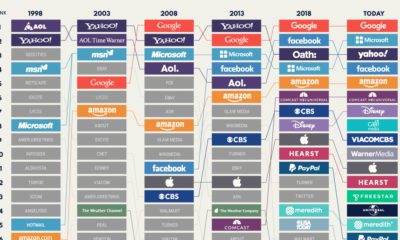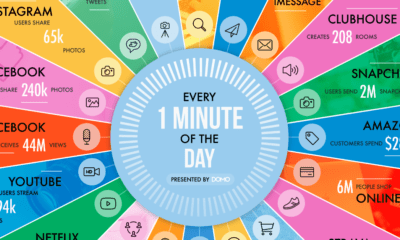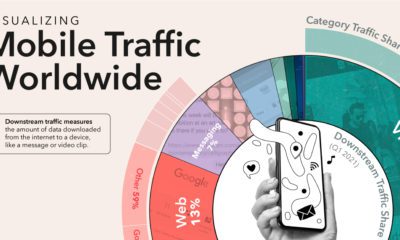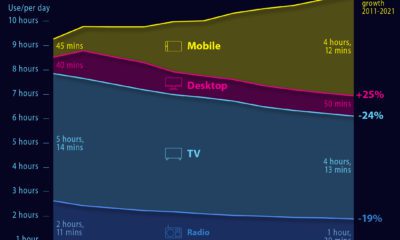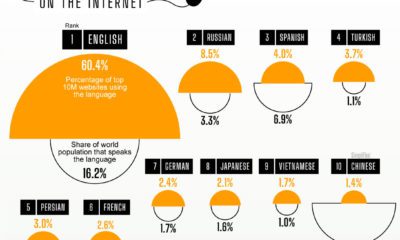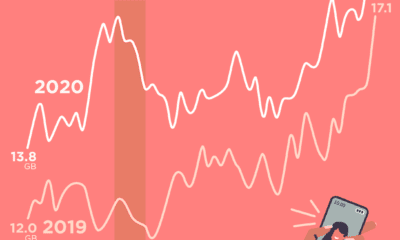Despite its widespread use, a significant portion of the global population still isn’t connected to the internet, and in certain areas of the world, the number of disconnected people skews towards higher percentages. Using information from DataReportal, this visual highlights which regions have the greatest number of people disconnected from the web. We’ll also dive into why some regions have low numbers, and take a look at which countries have seen the most growth in the last year.
Top 10 Most Disconnected, by Number of People
The majority of countries with lower rates of internet access are in Asia and Africa. Here’s a look at the top 10 countries with the highest numbers of people not connected to the web: *Note: Rankings only include countries/territories with populations over 50,000. Interestingly, India has the highest number of disconnected people despite having the second largest online market in the world. That being said, 50% of the country’s population still doesn’t have internet access—for reference, only 14% of the U.S. population remains disconnected to the web. Clearly, India has some untapped potential. China takes second place, with over 582 million people not connected to the internet. This is partly because of the country’s significant rural population—in 2019, 39% of the country’s population was living in rural areas. The gap in internet access between rural and urban China is significant. This was made apparent during China’s recent switch to online learning in response to the pandemic. While one-third of elementary school children living in rural areas weren’t able to access their online classes, only 5.7% of city dwellers weren’t able to log on. It’s important to note that the rural-urban divide is an issue in many countries, not just China. Even places like the U.S. struggle to provide internet access to remote or rugged rural areas.
Top 10 Most Disconnected, by Share of Population
While India, China, and Pakistan have the highest number of people without internet access, there are countries arguably more disconnected. Here’s a look at the top 10 most disconnected countries, by share of population: There are various reasons why these regions have a high percentage of people not online—some are political, which is the case of North Korea, where only a select few people can access the wider web. Regular citizens are restricted from using the global internet but have access to a domestic intranet called Kwangmyong. Other reasons are financial, which is the case in South Sudan. The country has struggled with civil conflict and economic hardship for years, which has caused widespread poverty throughout the nation. It’s also stifled infrastructural development—only 2% of the country has access to electricity as of 2020, which explains why so few people have access to the web. In the case of Papua New Guinea, a massive rural population is likely the reason behind its low percentage of internet users—80% of the population lives in rural areas, with little to no connections to modern life.
Fastest Growing Regions
While internet advancements like 5G are happening in certain regions, and showing no signs of slowing down, there’s still a long way to go before we reach global connectivity. Despite the long road ahead, the gap is closing, and previously untapped markets are seeing significant growth. Here’s a look at the top five fast-growing regions: Africa has seen significant growth, mainly because of a massive spike of internet users in the Democratic Republic of Congo (DRC)—between 2019 and 2020, the country’s number of internet users increased by 9 million (+122%). This growth has been facilitated by non-profit organizations and companies like Facebook, which have invested heavily in the development of Africa’s internet connectivity. India has also seen significant growth—between 2019 and 2020, the number of internet users in the country grew by 128 million (+23%). If these countries continue to grow at similar rates, who knows what the breakdown of internet users will look like in the next few years? on Even while political regimes across these countries have changed over time, they’ve largely followed a few different types of governance. Today, every country can ultimately be classified into just nine broad forms of government systems. This map by Truman Du uses information from Wikipedia to map the government systems that rule the world today.
Countries By Type of Government
It’s important to note that this map charts government systems according to each country’s legal framework. Many countries have constitutions stating their de jure or legally recognized system of government, but their de facto or realized form of governance may be quite different. Here is a list of the stated government system of UN member states and observers as of January 2023: Let’s take a closer look at some of these systems.
Monarchies
Brought back into the spotlight after the death of Queen Elizabeth II of England in September 2022, this form of government has a single ruler. They carry titles from king and queen to sultan or emperor, and their government systems can be further divided into three modern types: constitutional, semi-constitutional, and absolute. A constitutional monarchy sees the monarch act as head of state within the parameters of a constitution, giving them little to no real power. For example, King Charles III is the head of 15 Commonwealth nations including Canada and Australia. However, each has their own head of government. On the other hand, a semi-constitutional monarchy lets the monarch or ruling royal family retain substantial political powers, as is the case in Jordan and Morocco. However, their monarchs still rule the country according to a democratic constitution and in concert with other institutions. Finally, an absolute monarchy is most like the monarchies of old, where the ruler has full power over governance, with modern examples including Saudi Arabia and Vatican City.
Republics
Unlike monarchies, the people hold the power in a republic government system, directly electing representatives to form government. Again, there are multiple types of modern republic governments: presidential, semi-presidential, and parliamentary. The presidential republic could be considered a direct progression from monarchies. This system has a strong and independent chief executive with extensive powers when it comes to domestic affairs and foreign policy. An example of this is the United States, where the President is both the head of state and the head of government. In a semi-presidential republic, the president is the head of state and has some executive powers that are independent of the legislature. However, the prime minister (or chancellor or equivalent title) is the head of government, responsible to the legislature along with the cabinet. Russia is a classic example of this type of government. The last type of republic system is parliamentary. In this system, the president is a figurehead, while the head of government holds real power and is validated by and accountable to the parliament. This type of system can be seen in Germany, Italy, and India and is akin to constitutional monarchies. It’s also important to point out that some parliamentary republic systems operate slightly differently. For example in South Africa, the president is both the head of state and government, but is elected directly by the legislature. This leaves them (and their ministries) potentially subject to parliamentary confidence.
One-Party State
Many of the systems above involve multiple political parties vying to rule and govern their respective countries. In a one-party state, also called a single-party state or single-party system, only one political party has the right to form government. All other political parties are either outlawed or only allowed limited participation in elections. In this system, a country’s head of state and head of government can be executive or ceremonial but political power is constitutionally linked to a single political movement. China is the most well-known example of this government system, with the General Secretary of the Communist Party of China ruling as the de facto leader since 1989.
Provisional
The final form of government is a provisional government formed as an interim or transitional government. In this system, an emergency governmental body is created to manage political transitions after the collapse of a government, or when a new state is formed. Often these evolve into fully constitutionalized systems, but sometimes they hold power for longer than expected. Some examples of countries that are considered provisional include Libya, Burkina Faso, and Chad.
